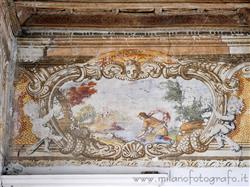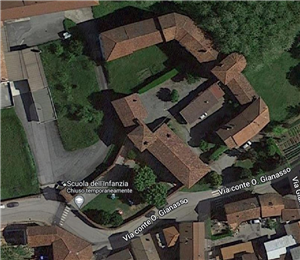|
Benna (Biella)- Castle
|
|
|
Show to visit in the Biella area: |
 The Castle of Benna was built in the eleventh century. Originally a ricetto (fortified part of the town owned by the inhabitants of the village) must have been associated with it, but of it only traces remain. The Castle of Benna was built in the eleventh century. Originally a ricetto (fortified part of the town owned by the inhabitants of the village) must have been associated with it, but of it only traces remain.
In 1402 the militar leader Facino Cane sowed destruction in the Biella area, so much so that the castle, then owned by the Avogadros, had to be rebuilt.
In 1479 Sebastiano Ferrero became the owner of a large part of the feud of Benna and therefore also of the castle. He enlarged the castle and at the beginning of the sixteenth century enriched it with an elegant Renaissance-style portico.
In the seventeenth century the castle was increasingly losing its defensive function to transform itself into a stately home.
It was in this century that Cristina di Simiana, wife of Francesco Lodovico Fieschi made the castle her temporary residence and the halls with painted ceilings and frescoed walls were built in the semicircular tower.
Then began the decline, with an increasing number of modifications and tampering with the structure.
In the twentieth century apartments were created from a part of the castle. The apex of the deterioration was reached after the Second World War, when the portico was closed and occupied by a factory.
Currently the castle is partly privately owned and partly municipal property and although its state has improved, this makes it difficult to fully enjoy it.
The complex has an irregular shape, with the various wings arranged to form more or less a rhombus, but with the entrance a little distanced, in a southwesterly direction. 
The entrance portal is still the original one, with a solid wooden door equipped with a pedestrian door. In the upper part of the portal there are still traces of frescoes.
There are still two of the towers with which the castle was originally equipped, both incorporated into the building structure of the castle. One coincides with the entrance, the other, the semicircular one, is located on the back, opposite to the first. In the entrance hall, under the square tower, there are still remains of Romanesque walls built with river pebbles arranged in a herringbone pattern, mixed with brick parts.
The same type of masonry can also be observed externally, on the north-east side, however difficult to observe due to the vegetation.
The north wing is characterized by the presence of the Renaissance portico (Fig. 3), above which there is a loggia. The arches of the latter reproduce on a smaller scale those of the portico, so that exactly two arches in the loggia correspond to each arch of the portico. In the spandrels of the arches on the ground floor there are medallions which originally must have contained frescoes, unfortunately lost. In the spandrels of the loggia, instead, frescoes of the Savoy coat of arms and of that of the Ferreros alternate.
The portico and the loggia are unfortunately not perfectly preserved and it is hoped that they can be restored in the near future.
The north-west wing, owned by the municipality, is also characterized by a masonry with pebbles interspersed with bricks and there is also a terracotta cornice with protruding teeth under the junction of the roof, the bricks of which were partly plastered to create a further zigzag decoration. In this wing, two single lancet windows later walled up are still recognisable, one of which bears the Savoy coat of arms.
The south wing, also with brick-cobblestone masonry and privately owned, is characterized by the presence of two single-lancet windows (Fig. 5), one of which is decorated with a multiple brick frame and decorative arches below of it.
The most valuable spaces are located inside the semicircular tower, which in fact can be better described as the sum of a rectangular tower to which half a circular tower of equal width has been added outside. Unfortunately, also the semicircular tower is not freely usable as it is in need of renovations.
Externally, it can already be seen that the two upper windows must originally have been surrounded by a rich frescoed frame, of which only the upper part remains. The frame simulated stuccos, scrolls and branches of fruit trees.
The floors inside the tower are connected by a spiral staircase.
The halls of the semicircular tower have painted coffered ceilings and various frescoes from the seventeenth century.
On the first floor there are three rooms, one semicircular (Fig. 4) and two rectangular.
The semicircular room and the first of the rectangular ones have a completely painted coffered wooden ceiling, with simulated knobs and stylized flowers. In the upper part of the walls, immediately under the roof, there is a frescoed band. These frescoes simulate baroque stuccos in relief depicting volutes and stylized plant elements of various kinds. In the semicircular room the background is ocher and at regular intervals there are frames with profane scenes inside. Furthermore, between the band with the false stuccos and the ceiling there is a thinner band depicting a sort of lace. In this room, the fresco decoration of the upper splay of the window should also be noted: in the center there is a tondo depicting a landscape in monochrome and around it four quadrants painted to simulate marbles of different colors.
In the first rectangular room the background of the friezes is honeycomb and on each side there are two frames supported by putti with scenes inside depicting allegories of Arrogance (larger picture), of Avarice, of Ignorance, of Fortitude, of Friendship, of Honour, of Luck and of Love (what is depicted is shown above on a plate).
Also in the second rectangular room there is a frescoed band under the ceiling, unfortunately however very deteriorated. The style is the same as that of the bands in the two other halls, albeit with some variations.
Two other rooms are then present on the second floor (unfortunately not visited because it was undergoing renovation). The decorative structure takes up that of the rooms on the first floor, with some variations. In the first room on the second floor the frames depict scenes of two different themes: on the one hand scenes with an ornithological theme (but in reality also having an allegorical meaning), on the other hand depictions of landscapes. It should be noted that here too a second thinner band is present immediately under the ceiling. It has a wheel motif on the sides with frames depicting bird scenes and a heart motif on the sides with frames depicting landscapes.
In this room there is also a band at the base of the walls to simulate marble panels. Decorations to simulate marble can also be found in the splays of the windows.
The second room on the second floor is very similar to the previous one, this time with frames containing rural landscapes in the band under the ceiling.
Finally, the presence of the coat of arms of Cristina di Simiana in the upper splay of the window of the small room on the ground floor deserves to be mentioned.
The decorations present in the Castle of Benna have many similarities with those present in other palaces owned by the Ferrero Fieschis, starting with the Palace of the Princes in Masserano.
Categories: Places of historical value of artistic value
Via conte O. Gianasso, 13, 13871 Benna BI
|
Castle: Further pictures in the section Photography |